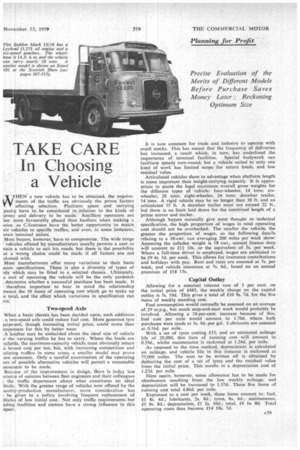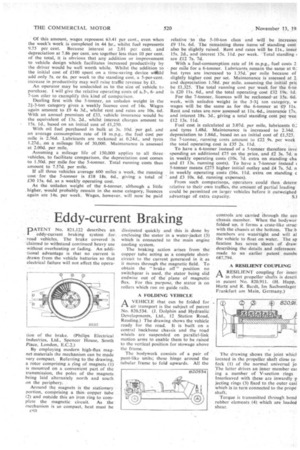TAKE CARE In Choosing a Vehicle ,
Page 201

Page 202

If you've noticed an error in this article please click here to report it so we can fix it.
• 11-IEN a new vehicle has to be obtained, the require ments of the traffic are obviously the prime factors affecting selection. Platform space and carrying .pacity have to. be considered in relation to the kinds of umey and delivery to be made. Ancillary operators are 'ten more favourably, placed than hauliers when making a toice, as C-licensees have the better opportunity to match eir vehicles to spe,cific traffics, and even, in some instances, lawn terminal potnts.
Most buyers, however, have to compromise. The wide range • vehicles offered by manufacturers usually permits a user to nain a vehicle to suit his needs, but there is the possibility at a wrong choice could be made if all factors are not ckoned with.
Most manufacturers offer many variations to their basic lassis specifications. There is also a diversity of types of xly which may be fitted to a selected chassis. Ultimately,
e cost of operating the vehicle will be the only yardstick determine whether a successful purchase has been made. It therefore important to bear in mind the relationship itween the 10 items of operating cost which go to make up e total, and the effect which variations in specification can we.
Two-speed Axle
When a basic chassis has been decided upon, such additions a two-speed axle could reduce fuel cost. More generous tyre luipment, though increasing initial price, could more than impensate for this by better wear.
A haulier may be undecided about the ideal size of vehicle ir the varying traffics he has to carry.. Where the loads are /affable, the maximum-capacity vehicle must obviously return ,c lowest cost per ton, but, with increasing competition and :dining traffics in some areas, a smaller model may prove ore economic. Only a careful examination of the operating ists of possible alternative vehicles will permit a reasonable ;sessrnent to be made.
Because of the improvement in design, there is today less triance of opinion between fleet engineers and their colleagues ; the traffic department about what constitutes an ideal :hide. With the greater range of vehicles now offered by the lantity-production manufacturer, more consideration has ; be given to a policy involving frequent replacement of ihicles of low initial cost. Not only traffic requirements but ading tradition and custom have a strong influence in this :Sped. t is now common for trade and industry to operate with small stocks. This has meant that the frequency of deliveries has increased, a result which, in turn, has underlined the importance of terminal facilities. Special bodywork can fa ilitate speedy turn-round, but a vehicle suited to only one IC d of work has limited scope for return loads, and low re idual value.
rticulated vehicles show to advantage when platform length is more important than weight-carrying capacity. It is approptte to quote the legal maximum overall gross weights for th different types of vehicle: four-wheeler, 14 tons; sixwheeler, 20 tons; tight-wheeler, 24 tons; drawbar trailer, 14 tons. A rigid vehicle may be no longer than 30 ft. and an articulated 35 ft. A drawbar trailer must not exceed 22 ft., but there is no limit laid down for the combined length of a prime mover and trailer.
Although buyers naturally give most thought to technical specification, the high proportion of wages in total operating cost should not be overlooked. The smaller the vehicle, the greater the proportion of wages, as the following details relating to a 10-cwt. van averaging 200 miles per week show: Assuming the unladen weight is 18 cwt., annual licence duty will amount to i12 10s. or the equivalent of 5s. per week. Wt ere a full-time driver is employed, wages are estimated to be E9 4s. 3d. per week. This allows for insurance contributions an holidays with pay. Rent and rates are assessed at 7s. per w ek, and vehicle insurance at 7s. 6d., based on an annual pr mium of f18 15s.
Capital Outlay
thawing for a nominal interest rate of 3 per cent. on th initial price of £485, the weekly charge on the capital outlay is 5s. 10d. This gives a total of £10 9$. 7d. for the five items of weekly standing cost.
Fuel consumption would normally be assessed on an average of 29 m.p.g., but much stop-and-start work would probably be involved. Allowing a 10-per-cent, increase because of this, fu 1 cost per mile would amount to 1.70d. where bulk hases were made at 3s. 9d.. per gal. Lubricants are assessed 0.16d. per mile.
ith a set of tyres costing £33, and an estimated mileage lif of 20,000, this item of running cost will amount to O. 9d., whilst maintenance is reckoned at 1.24d. per mile.
s opposed to the time method, depreciation is calculated or mileage, and vehicle life in this instance is reckoned at 75 000 miles. The sum to be written off is obtained by deffucting the cost of a set of tyres and the residual value fr rn the initial price. This results in a depreciation cost of 1. 5d. per mile.
ere again, however, some allowance has to be made for o solesence resulting from the low weekly mileage, and de eciation will be increased to 1.37d. These five items of running cost total 4.86d. per mile. Expressed as a cost per week, these items amount to: fuel, El &s. 4d.; lubricants, 2s. 8d.; tyres, 6s. 6d.; maintenance, El Os. 8d.; depreciation, £1 2s. 10d.; total, £4 Is. Od. Total o rating costs thus become f14 10s. 7d. • Of this amount, wages represent 63.41 per cent., even when the week's work is completed in 44 hr., whilst fuel represents 9.75 per cent. Because interest at 2.01 per cent. and depreciation at 7.86 per cent. are together less than 10 per cent. of the total, it is obvious that any addition or improvement to vehicle design which facilitates increased productivity by the driver would be well worth while. Whilst the addition to the initial cost of £100 spent on a time-saving device wtRild add only 5s. or 6s. per week to the standing cost, a 5-per-cent, increase in productivity may. well raise traffic revenue by £1.
An operator may be undecided as to the size of vehicle ti purchase. I will give the relative operating costs of a.5-, 6and 7-ton oiler to exemplify this kind of comparison.
Dealing first with the 5-tonner, an unladen weight in the 24-3-ton category gives a weekly licence cost of I4s. Wages again amount to £9 4s 3d., whilst rent and rates are 10s. 6d. With an annual premium of £33, vehicle insurance would he the equivalent of 13s. 2d., whilst interest charges amount to 15s. id., based on an initial cost of £1,250.
With oil fuel purchased in bulk at 3s. 10d. per gal. and an average consumption rate of 18 m.p.g., the fuel cost per mile is 2.56d. Lubricants are reckoned at 0.24d., and tyres on a mileage life of 30,000. Maintenance is assessed at 2.00d. per mile.
Assuming a mileage life of 150,000 applies to all three vehicles, to facilitate comparison, the depreciation cost comes to 1.50d. per mile for the 5-tonner. Total running costs thus amount to 7.57d. per mile. If all three vehicles average 600 miles a week, the running cost for the 5-tonner is £18 18s. 6d., giving a total of £30 15s. 6d. as a weekly operating cost.
As the unladen weight of the 6-tonner, although a little . higher, would probably remain in the same category, licences again are 14s. per week. Wages, however, will now be paid relative to the 5-10-ton class and will be increase( £9 1 Is. •6d. The remaining three items 'of standing cost. also be slightly raised. Rent and rates will be lls., insur 15s. 2d., and interest 15s. lid, per week. 'Total standing I are £12 7s. 7d.
With a fuel-consumption rate of 16 m.p.g., fuel costs 2 per mile for a 6-totmer. Lubricants remain the same at 0.: but tyres are increased to 1.35d.' per mile because of slightly higher cost per set. Maintenance is assessed at 2. and depreciation 1.58d. per mile, assuming the initial pric be £1,325. The total running cost per week for the 6-to is £20 1 ls. 6d., and the total operating cost £32 19s. Id.
For the 7-tonner, licences will be reckoned-at 15s. 6d. week, with unladen weight in the 3-34 ton category, w wages will be the same as for the 6-Wittier at -E? Us. Rent and rates are now assessed at 1/s. 6d., insurance 17s. and interest 18s. 3d., giving a total standing cost per wee £12 13s. Ild.
Fuel cost is calculated at 3.07d. per mile, lubricants 0.: and tyres 1.48d. Maintenance is increased to 2.34d. depreciation to 1.84d., based on an initial cost of £1,525. the 7-tonner, running costs amount to £22 9s. per week the total operating cost is £35 2s. 11d.
To have a 6-tonner instead of a 5-tonner therefore invo spending an additional £75 on the price, and £2 3s. 7d. n in weekly operating costs (10s. 7d. extra on standing cha and £1 13s. running costs). To have a 7-tonner instead 5-tonner means £275 higher initial outlay and £4 7s. 5d. n in weekly operating costs (16s. 11d, extra on standing c and £3 10s. 6d. running expenses).
From such comparisons, operators could then deterrr relative to their own traffics, the amount of partial loading could be permitted on larger vehicles before it outweighed advantage of extra capacity. 5.1
































































































































































































































































